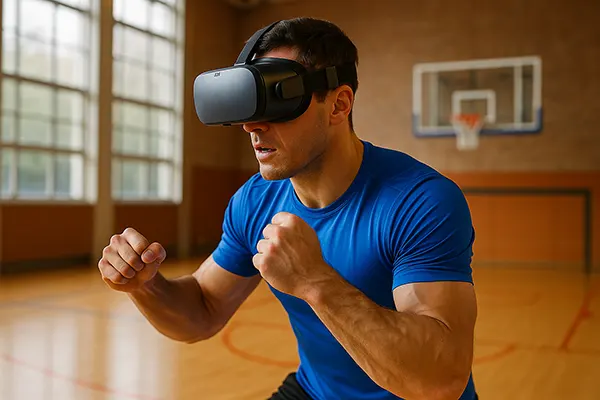Modern sport is no longer limited to physical training and tactical preparation. In 2025, technological solutions have become a crucial part of how athletes train, recover, and compete. From artificial intelligence to immersive VR experiences, innovation is redefining performance standards and offering fresh opportunities for clubs and players alike.
Smart Clubs and Connected Training Environments
Smart clubs are transforming the way athletes and coaches approach preparation. These training facilities integrate sensors, motion capture cameras, and biometric devices that track everything from heart rate to movement precision. The data is collected in real time, allowing immediate analysis and feedback during practice sessions.
Clubs across Europe, particularly in football and basketball, have implemented AI-powered dashboards. These systems translate complex data into practical recommendations for workload distribution, recovery schedules, and injury prevention strategies. Coaches can now personalise training plans with a level of accuracy previously unattainable.
Notably, Scandinavian tennis academies have started adopting smart courts equipped with automated line-calling technology and movement trackers. This approach helps players fine-tune footwork while reducing referee dependency during practice, leading to more independent development.
How Smart Technology Enhances Performance
Wearable trackers are central to this evolution. Devices placed on wrists, boots, or jerseys monitor biomechanics and provide detailed reports. These insights allow physiologists to detect small changes in posture or running technique before they escalate into injuries.
Additionally, smart clubs have embraced AI-driven nutritional analysis. By linking biometric results with dietary recommendations, athletes receive meal plans adapted to their energy expenditure and recovery goals. This integration bridges the gap between performance science and daily practice.
Finally, connected environments are valuable for mental preparation. Some clubs now use biofeedback tools to measure stress responses during high-intensity drills, enabling psychologists to train resilience and decision-making under pressure.
Sports Analytics and Artificial Intelligence
Data analytics has become indispensable in modern sport. Advanced algorithms process match footage and training sessions to reveal patterns that are invisible to the human eye. Clubs in football, rugby, and cricket now invest in AI platforms that generate predictive models of opponent behaviour and tactical options.
Beyond team sports, athletics federations have embraced performance analytics to refine sprinting, jumping, and throwing techniques. By comparing biomechanical data against historical databases, coaches can identify the smallest inefficiencies and correct them rapidly.
The financial dimension is equally important. Analytics departments help clubs optimise player recruitment by evaluating performance potential against market value. In 2025, transfer decisions in top leagues are increasingly shaped by data-driven scouting rather than intuition alone.
Applications of AI in Coaching and Scouting
AI systems now assist coaches by automatically tagging video footage with tactical events such as passes, turnovers, and defensive positioning. This automation reduces the workload of analysts and provides instant access to relevant clips for review.
Scouting has also changed dramatically. Instead of relying on subjective impressions, clubs use algorithmic models that assess players across dozens of variables, including fatigue resistance, acceleration bursts, and adaptability to tactical systems. This reduces transfer risks and strengthens long-term planning.
For grassroots sports, federations have introduced AI-based talent identification tools. Young players submit performance videos that are assessed against benchmarks, widening opportunities for discovery beyond traditional scouting networks.

Virtual and Augmented Reality Training
Virtual reality (VR) and augmented reality (AR) are gaining ground in sports training. VR headsets allow athletes to simulate match conditions, helping them rehearse decision-making under pressure without physical fatigue. Clubs in American football and Formula 1 already use VR extensively to prepare for complex tactical scenarios.
Augmented reality is equally influential. Basketball academies employ AR glasses to project tactical instructions during drills, ensuring that athletes receive live guidance while moving on the court. This method accelerates tactical learning by combining physical repetition with cognitive reinforcement.
Furthermore, VR and AR have opened opportunities for injury rehabilitation. Athletes recovering from knee or shoulder injuries can engage in simulated movements before returning to full physical contact, reducing the risk of relapse and boosting confidence in their recovery process.
Immersive Tools for Athlete Development
VR-based vision training is particularly effective for goalkeepers and tennis players. By practising with simulated fast-paced scenarios, they improve reaction times and hand-eye coordination without the physical wear of constant drills.
AR applications are also used for fan engagement during training sessions. Some clubs broadcast AR-enhanced practice to audiences, bridging the gap between spectators and the team. This combination strengthens commercial opportunities while supporting athletic development.
Universities and research centres contribute significantly to VR/AR progress. Their collaborations with technology firms ensure that products are tested scientifically before being adopted by professional clubs, making the training process both reliable and evidence-based.
